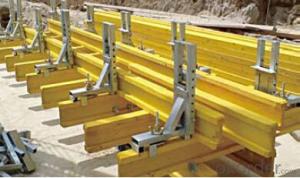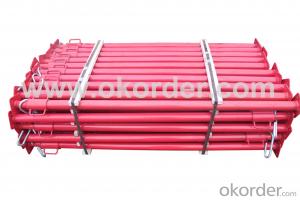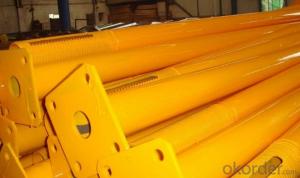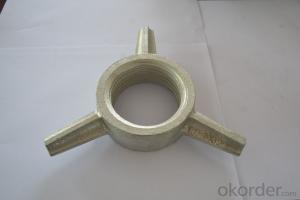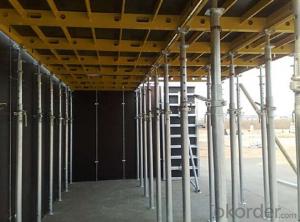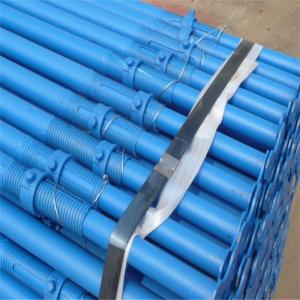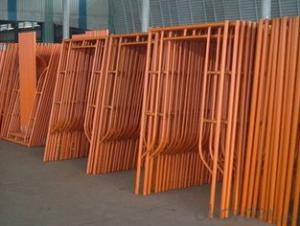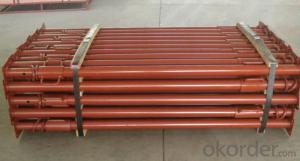Steel Prop & Tripod & Beam Clamp For Build
- Loading Port:
- Tianjin
- Payment Terms:
- TT OR LC
- Min Order Qty:
- 50 m²
- Supply Capability:
- 1000 m²/month
OKorder Service Pledge
Quality Product, Order Online Tracking, Timely Delivery
OKorder Financial Service
Credit Rating, Credit Services, Credit Purchasing
You Might Also Like
Steel Prop & Tripod & Beam Clamp
(1) Steel prop is a vertical support system widely used in construction.
Characteristics:
◆ Simple & flexible structure
◆ Easy & fast operation
◆ Economical efficiency
◆ Easy storage and transportation
◆ Reasonable load-bearing capacity
(2) Tripod is always used as support for steel prop.
(3) The beam clamp is a technical instrument for supporting beam formwork
which makes conventional beam formwork simple, and increases the construction
efficiency.
Characteristics:
◆ Flexible structure
◆ Optimum design proposal
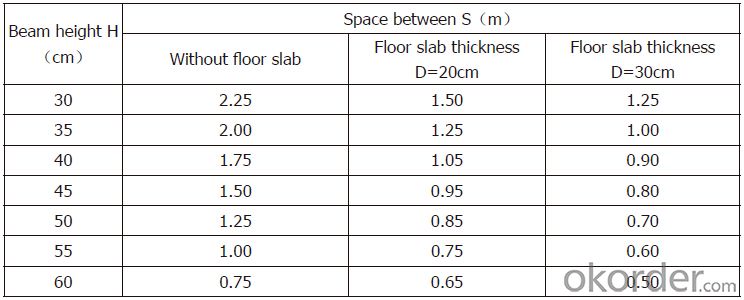
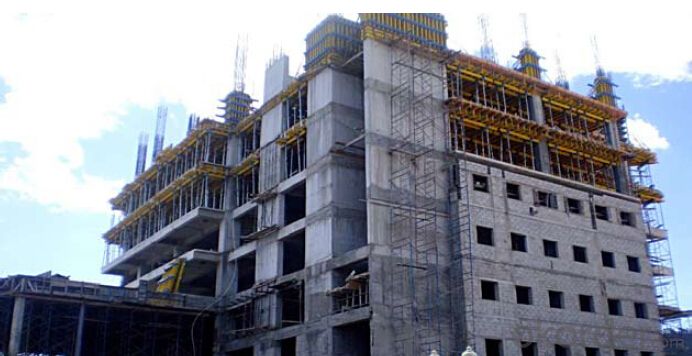
- Q:Are steel props resistant to ultraviolet (UV) radiation?
- Steel props are not inherently resistant to ultraviolet (UV) radiation. Steel is a material that can corrode and degrade when exposed to UV radiation over a prolonged period. However, this can be mitigated by applying protective coatings or finishes on the steel props that are specifically designed to resist UV radiation. These coatings act as a barrier between the steel surface and the harmful UV rays, preventing or minimizing the potential damage caused by the radiation. It is crucial to ensure that the protective coatings used are specifically formulated to withstand UV radiation and are applied correctly to provide maximum durability and resistance. Regular maintenance and inspections are also necessary to identify any signs of deterioration or damage caused by UV radiation and take appropriate actions to prevent further degradation.
- Q:Do steel props require any special training for installation?
- Yes, steel props do require special training for installation. Steel props are adjustable support systems commonly used in construction to provide temporary support to structures, such as walls, beams, or slabs, during construction or renovation. The installation process involves several important steps, including identifying the correct prop size and load capacity, positioning the props correctly, and ensuring proper alignment and stability. Training is necessary to understand the fundamentals of steel props, such as their safe load-bearing capacity, how to properly position and secure them, and how to adjust and maintain them as required. Specialized training provides knowledge about the different types of props available and their specific applications, as well as important safety considerations, such as preventing overloading or instability. Additionally, training helps individuals understand the potential risks and hazards associated with steel prop installation, including working at height, working with heavy equipment, and ensuring proper bracing and support to prevent accidents or structural failures. By receiving specialized training, individuals can gain the necessary expertise and skills to install steel props safely and effectively, minimizing the risk of accidents, ensuring structural stability, and contributing to a successful construction project.
- Q:What are the main advantages of using adjustable steel props?
- There are several main advantages of using adjustable steel props in construction and support applications. Firstly, adjustable steel props provide excellent load-bearing capacity. These props are designed to support heavy loads and can be adjusted to suit specific requirements. This makes them ideal for various construction projects, including supporting formwork, beams, slabs, and other structural elements. Secondly, adjustable steel props offer great flexibility. They can be easily adjusted to different heights, allowing for precise positioning and alignment. This adjustability feature makes them suitable for projects with varying requirements and allows for easy adaptation to changing conditions on the construction site. Another advantage of using adjustable steel props is their durability. These props are made from high-quality steel, which makes them strong, sturdy, and resistant to wear and tear. They can withstand heavy loads and harsh environmental conditions, ensuring their longevity and reliability. Furthermore, adjustable steel props are easy to use and install. They are lightweight and portable, making them convenient to transport and handle on-site. Their simple design allows for quick assembly and adjustment, saving time and labor costs during construction. Lastly, adjustable steel props have a cost-effective advantage. They are a cost-efficient solution compared to alternative support systems. Their reusability and long lifespan contribute to reduced project expenses, making them a cost-effective choice for construction projects. In conclusion, the main advantages of using adjustable steel props include their excellent load-bearing capacity, flexibility, durability, ease of use, and cost-effectiveness. These props provide reliable support for various construction applications and offer a practical solution for achieving stability and safety on the construction site.
- Q:Can steel props be used for temporary support in solar power plant construction?
- Yes, steel props can be used for temporary support in solar power plant construction. Steel props are strong and durable, making them suitable for providing temporary support during the construction phase of a solar power plant. They can be easily adjusted and secured in place, ensuring stability and safety during the construction process.
- Q:How do steel props compare to scaffolding systems?
- To support and stabilize construction projects, steel props and scaffolding systems are commonly utilized. However, their structure, versatility, and ease of use vary. Steel props, also known as acrow props, are adjustable telescopic steel tubes that extend or retract to provide support for different structures. They are primarily used for temporary structures like formwork, walls, and beams. Steel props are simple to install and adjust, making them popular for small to medium-sized projects. They are lightweight, portable, and easily transportable. Furthermore, they can be used individually or in combination to create a stable support system. In contrast, scaffolding systems are more intricate structures consisting of frames, tubes, and platforms. They are typically used in larger construction projects that require extensive support. Scaffolding systems offer a stable working platform for workers to access and work on various parts of a building. They are versatile and can be customized to suit project requirements. Scaffolding systems can be erected at different heights and configurations, ensuring a safe and efficient working environment. When comparing steel props and scaffolding systems, cost, installation speed, versatility, and safety are important considerations. Steel props are generally more cost-effective and quick to install compared to scaffolding systems, making them ideal for smaller projects with limited budgets and tight schedules. However, scaffolding systems provide greater versatility and can be tailored to meet specific project requirements, particularly for larger and more complex construction projects. In terms of safety, both steel props and scaffolding systems are designed to offer support and stability. However, scaffolding systems provide a more secure working platform with guardrails and handrails, ensuring the safety of workers at elevated heights. On the other hand, steel props may require additional safety measures such as scaffolding boards or platforms to create a stable working surface. To conclude, steel props and scaffolding systems have similar purposes in construction projects, but they differ in terms of structure, versatility, ease of use, and safety features. The choice between the two ultimately depends on the specific requirements and limitations of the project at hand.
- Q:Can steel props be used in airport terminal construction?
- Yes, steel props can be used in airport terminal construction. Steel props are commonly used as temporary support structures during construction to provide stability and reinforcement. They can be adjusted to different heights, making them versatile for various construction needs. In airport terminal construction, steel props can be employed for supporting formwork, scaffolding, or temporary beams, ensuring the safety and stability of the construction process.
- Q:Embedded dislocation, steel support how to put? Metro Shield Construction
- Estimates also corrected the past, relatively short, only to change the location of the bolt hole.
- Q:Are steel props suitable for use in high-voltage transmission line construction?
- High-voltage transmission line construction does not lend itself well to the use of steel props. These props, typically employed in construction activities for temporary structural support, are not ideal in this particular context for several reasons. First and foremost, high-voltage transmission lines carry extremely powerful electrical currents. Given steel's conductivity, using steel props in close proximity to these lines would heighten the risk of electrical accidents. Should the props come into contact with the transmission lines, they could conduct electricity, posing a significant danger to workers and potentially causing damage to equipment. Secondly, steel props may lack the necessary insulation properties required for high-voltage environments. High-voltage transmission lines often operate at voltages ranging from 69,000 volts to over 500,000 volts. It is imperative to ensure that any equipment employed in their construction is adequately insulated so as to prevent the occurrence of electrical discharge or arcing between the props and the transmission lines. Moreover, steel props may not possess the structural strength and stability necessary for high-voltage transmission line construction. These lines frequently span lengthy distances and endure various environmental factors such as wind, ice, and temperature fluctuations. The props employed in their construction must be capable of withstanding these forces and maintaining stability, which may not be guaranteed with steel props. Instead, specialized equipment and tools specifically designed for high-voltage transmission line construction are utilized. These include insulated aerial lifts, conductive ropes, and other safety gear engineered to meet the unique requirements and safety standards associated with working near high-voltage infrastructure. In conclusion, due to their conductive nature, lack of insulation properties, and potential structural limitations, steel props are unsuitable for high-voltage transmission line construction. Prioritizing safety and utilizing specialized equipment tailored to working in high-voltage environments is of utmost importance in order to minimize risks and ensure the successful completion of these projects.
- Q:How long can a steel prop be used on a construction site?
- The lifespan of a steel prop used on a construction site can vary depending on various factors such as the quality of the prop, the load it supports, and the conditions it is exposed to. However, with proper maintenance and regular inspections, steel props can be used for multiple construction projects, potentially lasting for several years.
- Q:Can steel props be used for temporary support during elevator installation?
- Yes, steel props can be used for temporary support during elevator installation. Steel props are commonly used in construction to provide temporary support to structures or components. They are adjustable and can be easily installed and removed as needed. When installing an elevator, steel props can be used to provide additional support to the elevator shaft or other components during the installation process. This ensures stability and safety while the elevator is being installed. Once the installation is complete, the steel props can be removed without causing any damage to the elevator or the surrounding structure.
1. Manufacturer Overview |
|
|---|---|
| Location | |
| Year Established | |
| Annual Output Value | |
| Main Markets | |
| Company Certifications | |
2. Manufacturer Certificates |
|
|---|---|
| a) Certification Name | |
| Range | |
| Reference | |
| Validity Period | |
3. Manufacturer Capability |
|
|---|---|
| a)Trade Capacity | |
| Nearest Port | |
| Export Percentage | |
| No.of Employees in Trade Department | |
| Language Spoken: | |
| b)Factory Information | |
| Factory Size: | |
| No. of Production Lines | |
| Contract Manufacturing | |
| Product Price Range | |
Send your message to us
Steel Prop & Tripod & Beam Clamp For Build
- Loading Port:
- Tianjin
- Payment Terms:
- TT OR LC
- Min Order Qty:
- 50 m²
- Supply Capability:
- 1000 m²/month
OKorder Service Pledge
Quality Product, Order Online Tracking, Timely Delivery
OKorder Financial Service
Credit Rating, Credit Services, Credit Purchasing
Similar products
New products
Hot products
Related keywords

